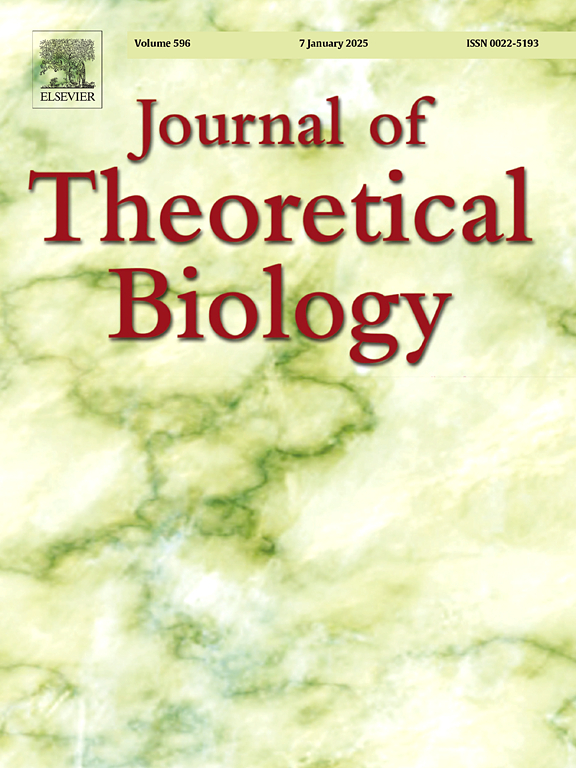PULSAR效应:通过微分方程揭示联合放射治疗和免疫疗法的潜在协同作用。
IF 2
4区 数学
Q2 BIOLOGY
引用次数: 0
摘要
PULSAR(个性化超分次立体定向自适应放射治疗)是一种放射治疗方法,患者将在几周内接受一次大剂量或 "脉冲 "放射治疗,而不是每天接受小剂量放射治疗。然后对肿瘤反应进行监测,以确定下一次脉冲放疗的时间。临床前试验表明,小鼠在接受免疫疗法的同时接受间隔 10 天的脉冲治疗,肿瘤反应会更好。然而,当脉冲间隔为 1 天或 4 天时,情况却并非如此。因此,当脉冲间隔一定天数时,就能观察到免疫疗法与 PULSAR 之间的协同效应。在我们的研究中,我们的目标是建立一个数学模型,通过考虑到脉冲间距的时间相关权重函数来捕捉协同效应。我们通过模拟退火算法拟合了六个治疗组的小鼠肿瘤体积数据,从而确定了可行的参数。将这些参数应用到模型中,我们模拟了 4000 次不同脉冲顺序的试验。模拟结果表明,如果脉冲间隔至少为 9 天,那么在使用 PULSAR 联合免疫疗法治疗时,肿瘤体积会缩小约 200 至 250 立方毫米。我们成功地证明了我们的模型易于实施,并能生成与临床前试验数据一致的肿瘤体积数据。我们的模型有望帮助开发 PULSAR 疗法的临床试验。本文章由计算机程序翻译,如有差异,请以英文原文为准。
PULSAR Effect: Revealing potential synergies in combined radiation therapy and immunotherapy via differential equations
PULSAR (personalized ultrafractionated stereotactic adaptive radiotherapy) is a form of radiotherapy method where a patient is given a large dose or “pulse” of radiation a couple of weeks apart rather than daily small doses. The tumor response is then monitored to determine when the subsequent pulse should be given. Pre-clinical trials have shown better tumor response in mice that received immunotherapy along with pulses spaced 10 days apart. However, this was not the case when the pulses were 1 or 4 days apart. Therefore, a synergistic effect between immunotherapy and PULSAR is observed when the pulses are spaced out by a certain number of days. In our study, we aimed to develop a mathematical model that can capture the synergistic effect by considering a time-dependent weight function that takes into account the spacing between pulses. We determined feasible parameters by fitting murine tumor volume data of six treatment groups via simulated annealing algorithm. Applying these parameters to the model we simulated 4000 trials with varying sequencing of pulses. These simulations indicated that if pulses were spaced apart by at least 9 days the tumor volume was about 200 to 250 smaller when treated with PULSAR combined with immunotherapy. We successfully demonstrate that our model is simple to implement and can generate tumor volume data that is consistent with the pre-clinical trial data. Our model has the potential to aid in the development of clinical trials of PULSAR therapy.
求助全文
通过发布文献求助,成功后即可免费获取论文全文。
去求助
来源期刊
CiteScore
4.20
自引率
5.00%
发文量
218
审稿时长
51 days
期刊介绍:
The Journal of Theoretical Biology is the leading forum for theoretical perspectives that give insight into biological processes. It covers a very wide range of topics and is of interest to biologists in many areas of research, including:
• Brain and Neuroscience
• Cancer Growth and Treatment
• Cell Biology
• Developmental Biology
• Ecology
• Evolution
• Immunology,
• Infectious and non-infectious Diseases,
• Mathematical, Computational, Biophysical and Statistical Modeling
• Microbiology, Molecular Biology, and Biochemistry
• Networks and Complex Systems
• Physiology
• Pharmacodynamics
• Animal Behavior and Game Theory
Acceptable papers are those that bear significant importance on the biology per se being presented, and not on the mathematical analysis. Papers that include some data or experimental material bearing on theory will be considered, including those that contain comparative study, statistical data analysis, mathematical proof, computer simulations, experiments, field observations, or even philosophical arguments, which are all methods to support or reject theoretical ideas. However, there should be a concerted effort to make papers intelligible to biologists in the chosen field.

 求助内容:
求助内容: 应助结果提醒方式:
应助结果提醒方式:


